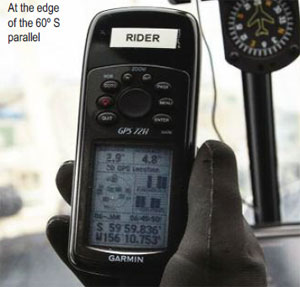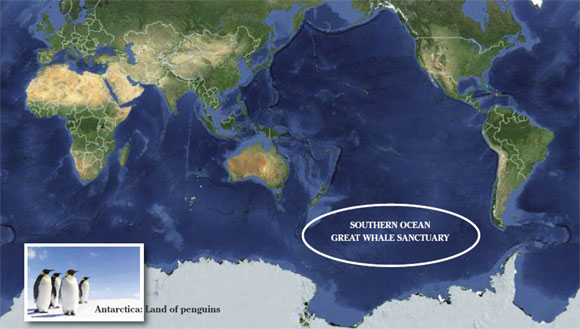|
 For many reasons, most of us on earth will perhaps find no cause for visiting the Southern Ocean ever. Firstly, it’s quite daunting to be sailing in latitudes beyond 50º–60º in the southern hemisphere, in the wide, open seas for weeks. Secondly, there is large-scale oceanic upwelling—primary means by which deep, dense water is brought to the surface. Thirdly, there are intense cyclonic storms for which terms such as the “furious fifties” and “shrieking sixties” have become part of navigational folklore. Fourthly, the average wind speeds in the Southern Ocean are the strongest in the world. Fifthly, there is no habitation nearby and normal sailing ships would find no reason to go there. For many reasons, most of us on earth will perhaps find no cause for visiting the Southern Ocean ever. Firstly, it’s quite daunting to be sailing in latitudes beyond 50º–60º in the southern hemisphere, in the wide, open seas for weeks. Secondly, there is large-scale oceanic upwelling—primary means by which deep, dense water is brought to the surface. Thirdly, there are intense cyclonic storms for which terms such as the “furious fifties” and “shrieking sixties” have become part of navigational folklore. Fourthly, the average wind speeds in the Southern Ocean are the strongest in the world. Fifthly, there is no habitation nearby and normal sailing ships would find no reason to go there.
And so, when a handful of men and women set sail into one of the farthest and remotest corners of the earth such that a few thousand whales may live, remain protected, and not be butchered, and thereby continue to preserve our marine ecosystems, it is infinitely courageous. These men and women have found their cause, and are wedded to it. They belong to the well known global conservation group, Sea Shepherd.
Year after year they venture out into those immensely harsh waters, sometimes so choppy and turbulent that ships begin to rock like little dinghies. They are out there in the unknown, largely uncharted territory, part of the world’s fourth largest oceanic system into which the least number of voyages have ever been made by man. These men and women have conquered fear to be among the giant marine mammals, and a great variety of them, such that these mammals can literally have a whale of a time. And so that they are prevented from becoming packaged meat in Japanese supermarkets. Nelson Mandela once philosophized that “courage was not the absence of fear, but the triumph over it.” Mandela’s words are true for those at Sea Shepherd who leave fear behind at the harbors once they sail forth into the daunting southern waters.
THE WHALE SANCTUARY
The Southern Ocean Whale Sanctuary is an area of about 5 million square miles, on the fringes of the continent of Antarctica. The International Whaling Commission (IWC) has banned all types of commercial whaling there. It was established in 1994 with 23 countries supporting its formation, and Japan opposing it. Most of Sea Shepherd’s activities take place around the 55º–60º S parallels, where least protection is available, and poaching has been rampant. On March 31, 2014, the International Court of Justice (ICJ) ruled that Japan’s whaling programme—one which the nation has long claimed is for scientific purposes—is just a smoke screen for commercial whaling operations. The ICJ said that by “…. Granting special permits to kill…fin, humpback and Antarctic minke whales….Japan has not acted in conformity with its obligations under paragraph 10 (e) of the Schedule to the International Convention for the Regulation of Whaling.”
For several years Japan’s Institute of Cetacean Research has continued to hunt whales inside the Sanctuary for the purposes of scientific research. Japan’s position for long has been that while some whale species are threatened, those such as the minke whales are not. But conservationists who unequivocally propound and promote established conventions laid out in the Antarctic Treaty System of 1972 point out that their ultimate goal is to preserve marine life and environmental integrity in and near Antarctica. The System was established in large part after concerns arose that krill catches could jeopardize marine food chains. Conservationists also point that Japan refuses to make the information it collects available for independent review. Conservation groups such as the Sea Shepherd claim that Japan’s self-imposed annual quota of 1,000 whale kills for research is not exactly scientific activity since most of the kills end up as whale meat in Japanese markets.
WHALE MEAT IN JAPAN
Whale meat has traditionally been considered a part of Japan’s high-protein diet. Different cuts of whale meat have specialized names. The main cuts are the belly meat and the prized tail meat, the latter consumed as sashimi or tataki. Fin whale has traditionally been considered superior, while the blue whale’s tail fin has been a delicacy along with its tongue. Dozens of dishes are cooked including the popular cubed and grilled blubber, cartilage salads and whale skin stew. But since conservationists stepped up the heat on the whale poachers, especially in the Southern Ocean, availability has been going down steeply.
SEA SHEPHERD
The Sea Shepherd concluded its 10th Antarctic Whale Defence Campaign called Operation Relentless on March 22, 2014. Having first located the poachers on January 5, 2014, the Sea Shepherd’s fleet comprising The Bob Barker and The Steve Irwin actively pursued the Japanese whalers. They located the factory vessel, Nisshin Maru, on four separate occasions. During the course of Operation Relentless, the Sea Shepherd fleet encountered night-time ambushes, including a collision between a harpoon vessel and The Bob Barker. But for three months on the high seas, the pursuers remained single-minded and unrelenting.
The captain of The Bob Barker, Peter Hammarstedt went on record saying that “although the whale poachers have not yet released the number of whales they have killed this season, we are confident that they have not even reached one-quarter of their bogus self-allocated quota, and estimate that our efforts have saved over 750 whales.” He added, “we are gladdened by the thought that these whales are swimming with us on their migration north, and proud that our tenth Antarctic Whale Defence Campaign has been a true testament to how relentless we can be.”
Captain of The Steve Irwin, Siddharth Chakravarty (see interview), said, “Using their aggression the poachers ran, but they could not hide from us. This is the longest that the Sea Shepherd Fleet has ever remained in the Southern Ocean, as the whalers desperately tried to make up for profits lost due to Sea Shepherd’s direct intervention. After 94 days at sea, I am honoured to return to port at the helm of The Steve Irwin.” He added, “am deeply proud to be a part of this organisation, vigilant in our defence of life in our oceans, relentless in our pursuit of justice for the whales.”
Managing Director of Sea Shepherd Australia, Jeff Hansen, stated, “I take my hat off to the Captains and crew of Operation Relentless. These whale poachers, heavily funded and backed by the government of Japan, have thrown absolutely everything at us and we have come out on top.”
Over the course of its previous nine Antarctic Whale Defence Campaigns, Sea Shepherd has saved the lives of 4,500 whales and remains the only organisation committed to upholding the sanctity of the Southern Ocean Whale Sanctuary, directly intervening against the illegal operations of the Japanese whaling fleet.
While most of us may never find one, the men and women at Sea Shepherd have certainly found a cause to keep returning to the Southern Ocean.

|